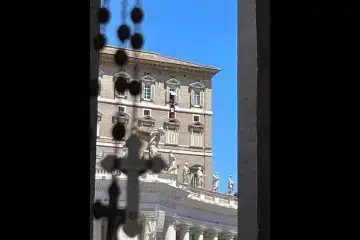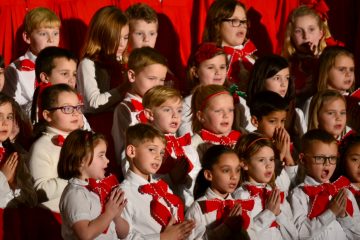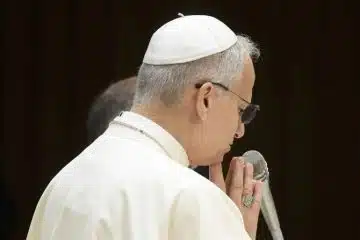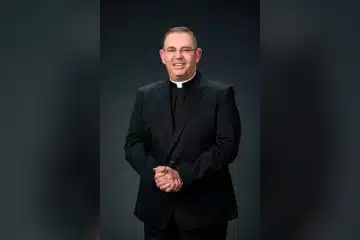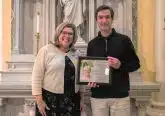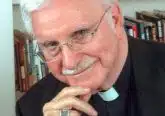Educating for Eternity
What if every math problem, science lab, or book discussion in a Catholic school was also a lesson about God?
That’s the heart of Education for Eternity, a growing initiative across the Archdiocese of Cincinnati. It’s not a new curriculum or program—it’s a shift in perspective. Rooted in the belief that Catholic education is ultimately about forming saints, Education for Eternity invites teachers to see every subject as a pathway to heaven.
“This isn’t just about adding faith to what we already teach—it’s about seeing everything through the lens of faith,” said Al Kovacic, director of campus ministry at Elder High School. “We’re not just preparing students for college or careers. We’re preparing them for eternal life.”
The phrase “educating for eternity” comes from a book by Catholic theologian Brett Salkeld, Educating for Eternity: A Teacher’s Companion for Making Every Class Catholic. “Over the last three years, we have been slowly introducing the book and its concepts to all the various groups that the Catholic Identity department works with, such as high school and elementary religion reps, as well as cohorts of principals,” said Veronica Murphy, director of Religion Curriculum and Resources for the Archdiocese of Cincinnati. “Because of our work, some teachers and principals have introduced it to their staff. We find this very encouraging.”
At Elder High School, faculty will begin using the book for professional development this fall. Kovacic first encountered it two years ago at Bishop Chatard High School in Indianapolis, where their campus minister is using the book with faculty throughout the year.
“He paired teachers from different departments—like religion and science, or English and art—and had them collaborate on ways to integrate a Catholic worldview into their subjects,” Kovacic said.
Inspired by that approach, Elder plans to launch its own version of the initiative by putting the book into the hands of every teacher this summer. “The hope is to get everyone on the same page and create a culture where Catholic identity isn’t just present, it’s everywhere,” Kovacic said.
That spirit of integration, not isolation, is what sets Educating for Eternity apart. It’s not about squeezing a Bible verse into a science lesson or tacking a saint of the day onto a history class. It’s about recognizing that the Gospel naturally permeates every discipline when approached with intention.
“Catholic education stands out because it doesn’t stop at forming good students or good citizens,” Kovacic said. “Our job is to lead students to heaven. That’s the ultimate goal, and everything we do should support it.”
Murphy agrees. “Education for Eternity is the understanding that we are educating students knowing that our ultimate goal is to live with God in heaven,” she said. “While we certainly want our students to receive an excellent education and be prepared for their vocations in this life, our goal for all our students is heaven.”
That mission has only grown more urgent. With fewer priests and religious teaching in schools, lay educators are carrying the responsibility of faith formation. Many are not trained theologians, and even those strong in their faith can feel uncertain about how to integrate it into subjects like math or literature.
That’s where Salkeld’s book offers both inspiration and practical support. “The book helps teachers see that Catholic anthropology—the belief in the dignity and destiny of the human person—can shape the way we approach every topic,” said Kovacic. “It’s not about being preachy. It’s about teaching with purpose.”
Murphy noted that, with the positive reception they have received from the small groups, they are currently incorporating the book into their communications, working with teams from other schools, and have even invited Brett Salkeld to come to the Archdiocese of Cincinnati in the fall of 2026.
“Our goal is to have representation from all schools. This is something every Catholic educator can connect to, because it’s why we do what we do,” she explained.
Ultimately, the hope is that Catholic schools will experience a cultural renewal—a shift where faith isn’t confined to theology class or morning prayer, but becomes the foundation for how every subject is taught.
“The goal is to refresh our Catholic schools in the mission of the Church to evangelize students and their families to build the Kingdom of God,” Murphy said.
That vision is already taking root.
“We’re just getting started,” Kovacic said, “but I can already tell there’s excitement among the faculty. People want to teach with meaning. They want their work to matter.”
This article appeared in the August 2025 edition of The Catholic Telegraph Magazine. For your complimentary subscription, click here.



